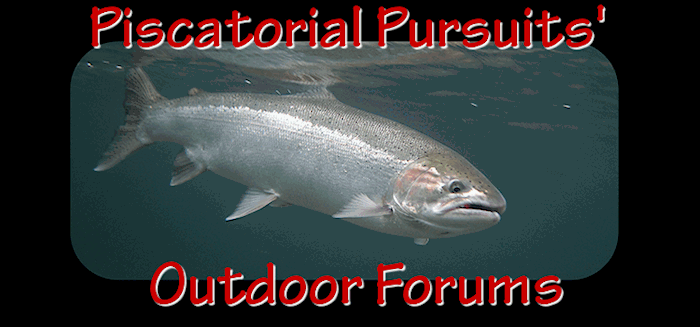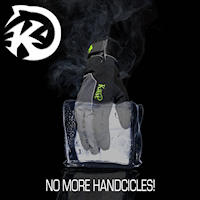Some people have asked about the economic value of hatchery salmon and steelhead. We've had a record year for them in the NW, and it's not over yet! The sportfishing money issues are thoroughly addressed in this following news release from the U.S. Dept. of Fish and Wildlife; in conjunction with NSIA. It is a long piece, but full of interesting info. It is a little too pro hatchery for my beliefs, but that is these people's business; and it is apparent in their self promotionalism here - which is OK of course. [But I put in some commentary and questions in these square parenthese, throughout - tough not to]. ...
The last sentence is very important to us sportfishers. It says that via our sportfisher's spending that "hundreds of millions of dollars in excise taxes on fishing and hunting equipment go to state fish and wildlife agencies". And that does not include license fees and other sportfisher's economic contributions! However, they did NOT say how much Indian Tribal gillnetter's money or commercial gillnetter's money went into the production of all these hatchery fish they benfit from (and that the Indians get so much more of despite the Treaties and Fed Ct. mandates); likely because it's politically sensative to their situations. .....
USF&WS release:
September 7, 2001
More than one million coho salmon, 500,000 steelhead and 300,000
Chinook salmon -- many from hatcheries operated or funded by the U.S. Fish
and Wildlife Service -- are expected to return to the Columbia River basin
this fall, fueling the biggest fishing frenzy in decades and generating
millions of dollars for local economies.
Already, the fall catch at the mouth of the Columbia has totaled about 12,000 Chinook and 211,000 coho. The Oregon Department of Fish and Wildlife reports a total of approximately 158,000 angler trips to Buoy 10 and the ocean specifically to take advantage of the run.
Spring fishing was awesome, too. Some 391,000 adult spring chinook crossed Bonneville Dam, the largest return since counting began when the dam was built in 1938. For the first time in 24 years, anglers were able to fish for spring Chinook in the lower Columbia River mainstem and the mainstem between The Dalles Dam and McNary
Dam. [How many did the sportfishers catch?]
Columbia River tribes had their largest mainstem harvest since 1955. [HOW MANY??? - RT] They have had little or no commercial fishing for spring chinook in the
Columbia River mainstem since 1977. [We've had none or nothing since well before '77]
All of this means an economic bonanza for many local businesses.
"This is about the Northwest lifestyle rekindled, because this run has been about catching not just fishing," said Paul Mayer, president of Stevens Marine, a boat retailer with stores in Milwaukie, Tigard and
Medford. "I've seen the looks on people's faces who've been out there and it reminds me of the runs in the 1970's that got them interested in fishing to begin with."
A national survey shows that each angler trip is conservatively worth
about $103 to the local economy. [That's per person per trip!] The spring/summer sport fishery this year, also record-setting, pumped about $16 million into communities on both sides of the Columbia River. That figure doesn't include money spent
catching fish in the tributaries, which is estimated to total about $700,000. Approximately 70,000 angler trips are expected inland, where fish returns to tributaries are also great.
"These are the good old days," said Liz Hamilton, director of the Northwest Sportfishing Industry Association [NSIA]. "This shows us what salmon can
do when they're given what they need, and that's healthy river systems. [And the ocean?] These phenomenal numbers show us that we have to keep mass-marking fish at
hatcheries and by doing that, we can give tremendous economic benefit to communities while protecting wild runs." [I hope so for the wild runs part of that!]
Eighty-five percent of hatchery Chinook and coho returning up the Columbia are fin-clipped to identify them as hatchery fish and legal to catch. [The Columbia Tribal Commission is pushing hard to stop the fin-clipping of salmon and steelhead, likely so as to cut out sportfishing opportunity!] Anglers must release unclipped fish, which may be wild and protected under the federal Endangered Species Act [except for the Indian nets].
Fisheries scientists attribute this year's record-setting runs to improved ocean conditions and good river flows in 1996 and 1997, years when juvenile fish were migrating to sea. The huge hatchery returns, some of the largest on record, also got a boost from the effects of habitat restoration, screening at irrigation canals, and improvements to federal dam operations on the Columbia River [I would love to hear more about these dam imporvements]. Improvements in hatchery operations and
fish culture technology [these too] coincided with these efforts to set the stage for great survival and returns of hatchery fish this year.
Preliminary information shows that wild salmon also are responding to
improved conditions. However, threatened and endangered runs were so depressed at the time of their listings in the early 1990's it will take years for them to recover. [Especially if gillnetting is allowed to continue in the Columbia]
About 80 percent of the returning fish are from Columbia Basin hatcheries operated by the Fish and Wildlife Service, the states of Oregon, Washington and Idaho, and Columbia Basin tribes. The Service's
contribution is especially evident in returns of fish above Bonneville Dam,
where more than half of all hatchery fish released are reared or funded by the Service [our money] to mitigate for construction of federal dams.
Some of the hatcheries, such as the Spring Creek National Fish Hatchery, which celebrates its centennial in Underwood, Washington, this weekend, have been rearing fish for a hundred years or more and protecting unique stocks of salmon that would not have survived as their habitat
disappeared in reservoirs behind dams. [?]
"Hatcheries have been part of the equation to salmon restoration for
more than 130 years in the West," said Dan Diggs, Assistant Regional Director of Fisheries for the Service's Pacific Region, based in Portland, Oregon. "In the last decade we have learned that they can be part of the solution or part of the problem if not operated correctly.
"The Service believes, as do our state, tribal and federal partners, that they can be part of the solution to ensuring salmon for everyone [the tribes want them for everyone?] in the future when operated under strong conservation principles and in concert with other habitat and fishery management efforts," Diggs said.
"The smiles on the faces of sport, tribal, and commercial fishermen and fish watchers this year are wonderful to see. But we all know it will take a continued concerted effort to repeat this year's returns in the future. And when we see the wild cousins of these hatchery fish return in the same
numbers, we'll really know we've done the job right." [Not in our lifetime!]
Fish production at federal hatcheries has been near capacity at most facilities in the Columbia Basin, primarily to meet mitigation requirements for salmon lost to dams [mostly for the Indians - truth]. Improvements in rearing practices have produced healthy, resilient fish. The Service has been a leader in
developing and researching fish culture technology for more than 100 years
and continues that tradition today, with research on genetics, fish diet,
health and new culture technologies.
An area of keen interest and research in which the Service and others are involved is determining whether hatchery fish, so long bred and reared in hatcheries, can now be used in restarting or supplementing depressed naturally spawning runs that can sustain themselves. The answer to that
question may go a long way to defining hatcheries' roles in the future. [ ]
For now, one thing is clear: The hatcheries are helping make anglers
and retailers happy. [ ] [But how about the Indians - happy? I think so!]
Retailers in communities near the river report that their cash registers are ringing as a result of the great salmon runs. Some stores are having to reserve bait for anglers. Bags of ice and plastic vacuum seal
bags were in short supply because of the heavy catch. Fish tackle shelves are nearly bare in some retail stores. In August, anglers were waiting three to five hours to launch their boats at the Warrenton/Hammond marina on the northern Oregon Coast. [ ]
"One in four fishermen I see say they haven't been fishing in 10 to 15 years, but now they're coming back," said Judy McNeal, owner of Chinook Bait and Tackle in Chinook, Washington. "One man landed a 22- pound Chinook on a broken pole. I put him on my store's wall of fame." [Coo...]
Charter businesses attest to the attraction this year's run holds for
people across the country. "I had a group of people go out recently who hadn't been fishing for 20 years. They were from Oklahoma, Louisiana and California, all coming up here because they want one of those salmon," said Milton Gudgell, owner of Pacific Salmon Charters in Ilwaco, Washington. [Do we want them here catching our fish too, guys? With this many fish, sure, why not.]
Richard "Oly" Olson, owner of Tiki Charters in Astoria, said he has been "inundated" with business. "This is the best season since I started this business six years ago," Olson said . " People said I should get my head examined for buying into
the charter fishing business, but things go in cycles - this year the ocean conditions have been great."
Inland, economic impacts are being felt just as strongly. Dan Grogin, owner of Fisherman's Marine and Outdoor in Oregon City and at Delta Park, said he's having the best year he's had in 26 years of
business. "A good year like this makes a difference in whether I employ 105
people or 85," he said. "There's probably $100 million worth of boats at the mouth of the Columbia River right now." [Dan!'s boat must be about a good couple thousand of that, eh? ]
Grogin's stores sold gear to commercial salmon trollers until 1982, when that market became too depressed and his stores switched to sportfishing supplies. "This year's been incredible," he said. "As long as we keep the hatcheries going and keep marking fish maybe things will be good." [How about the nates for the future owners of the store?]
The U.S. Fish and Wildlife Service is the principal Federal agency responsible for conserving, protecting and enhancing fish, wildlife and plants and their habitats for the continuing benefit of the American
people. The Service manages the 94-million-acre National Wildlife Refuge System which encompasses more than 535 national wildlife refuges, thousands of small wetlands and other special management areas. It also operates 70 national fish hatcheries, 64 fishery resource offices and 78 ecological
services field stations. The agency enforces Federal wildlife laws, administers the Endangered Species Act, manages migratory bird populations, restores nationally significant fisheries, conserves and restores wildlife habitat such as wetlands, and helps foreign governments with their
conservation efforts. It also oversees the Federal Aid program that distributes hundreds of millions of dollars in excise taxes on fishing and hunting equipment to state fish and wildlife agencies.
---------------
Hmmm - interesting for sure. ... Your guy's take on all of this? Please excuse some of my [irreverance].
RT













 Previous Topic
Previous Topic Index
Index

